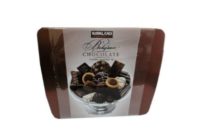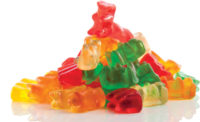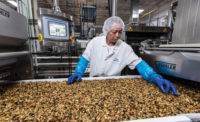In the past, private-label candy usually meant confections that didn’t have a national branded presence, like orange slices, ball gums, starlight mints, gummi bears and circus peanuts.
But as more shoppers become willing to reach for candy without a brand name, that’s all changing. For proof, look no further than Overseas Food Trading’s top selling private label candy — a premium, all-natural chocolate truffle.
In fact, Etienne Lemarie, the company’s sales manager, says about 80% of the company’s customers sell private-label truffles.
“We see that a lot of them want private label because they know they can have a better price from us and that gives them better quality under their private label,” Lemarie says.
“One of our customers, they really want to be sure it’s pure cocoa butter and chocolate. They’re very concerned about ingredients. But most customers are mainly concerned about value and taste. One cannot go without the other.”
The category has come a long way since it went by the infamous “generic” name, and the stigma usually attached to private label seems to be lifting.
Overall, private-label candy sales were up 4.3% at $11.8 billion in 2012, according to data from the Private Label Manufacturers Association (PLMA).
Specifically, chocolate candy was up 2.1% at $4.7 billion, while chocolate miniatures stayed steady at $1.3 billion. And breather sweeteners were also steady, with $237.7 million in sales. Non-chocolate candy saw the biggest increase, with a 9.9% jump over last year to $3 billion.
“The recent recession has dramatically changed the mindset. People are trying to stretch limited dollars,” says Michael Besso, sales and marketing director for Thompson Chocolate. “More retailers are trying to provide added value. The quality level has been raised. The stigma has been removed.”
Overall, the private-label sector as a whole is doing well in part because stores are requesting private label in an effort to brand themselves and show their own identity.
Walgreens, in particular, is a prime example of this, says Dane Twining, PLMA’s director of public relations.
Following their acquisition of Duane Reade, Walgreens adopted that chain’s premium Good & Delish store brand program, he explains. And, throughout 2012, Walgreens continued to roll out it’sNice! brand across the chain, which includes a significant proportion of candy items.
Richard A. Alimenti, ceo of Original Gourmet, which is known for its premium lollipops, says his company has found a lot of success making private label tins featuring fudge or cookies for retailers such Target, Macy’s and Staples for the same reasons — retailers are looking to solidify their own brands in creative ways.
“We have a manufacturing plant in china that makes the tins for a very good price, we’ve been doing this for 11 years,” he says. “So if Macy’s wants a cookie produced, we can make that tin exactly to the size, shape, style they want. And we have a design team of four people that will design the tin to be specific to that customer.”
The tins give the companies an option that can set their private label product apart, especially around the holidays.
“Let’s say you want to drive your private label sales. You can just take Christmas and do whatever, and create your assortment, or you can drive your private label brand through doing creative cookie tins,” Alimenti explains. “My idea is this, use seasonal to drive your brand. That’s what I do with the Original Gourmet brand. “
Private label chocolate gets premium
Of course, the best proof that the stigma is being lifted off the sector is probably the fact premium products are doing so well.
In fact, in the past year, sales of chocolate boxes, bars and bags weighing more than 3.5 oz. have jumped 9.1% to about $1 billion for the latest 52 weeks ending Dec. 2, 2012, reports Symphyony IRI, a Chicago-based research firm.
The increase suggests a trend that manufacturers will confirm anecdotally — shoppers are reaching for the larger, gourmet chocolate bars as they look for premium candy at a lower price point.
For example, Canada-based Lamontagne offers a range of premium chocolates in high-end flavors such as grilled macaroons milk chocolate, cranberry and 73% cocoa dark chocolate. The company also boasts that its candies are made in a peanut-free facility.
In addition, Tina Lamontagne says the company offers custom formulations, often using Barry Callebaut chocolate. And the company will design marketing and labeling for private-label candy.
She says the business is growing, as more shoppers become open to high-end, private label chocolate.
Rich Anderson, v.p. of business development with World Wide Gourmet Foods, says a lot of thought and creativity goes into the private-label candy his company sells. The line includes biscotti bites, espresso caramel almonds, and a Key Lime bar.
“I don’t think private label is perceived as less quality anymore,” Anderson says.
It’s not just private label chocolate that’s evolving though.
Private-label gum evolves
Roger McEldowney, with Ford Gum and Machine, which makes private-label gum, says overall private-label gum sales have increased at a rate greater than the overall gum category in every year since the company first began tracking it back in 2009.
And, data from Symphony IRI shows that overall private label regular gum sales were up 1.5% last year, at $4.7 million.
That’s partly because of the increased number of private-label, store-brand gums on the market, including: Superfresh (A&P/Pathmark),Ultrafresh (Tops Markets), DeLish (Duane Reade), Weis Quality (Weis Markets), Starbucks, Candy Place (Giant Eagle), and Excitemint (Aldi), among others.
McEldowney credits the growth to the fact that private-label is gum being made to taste very similar to national bands, coupled with the introduction of more attractive display options like floor shippers and power wings. Then there’s the value, of course.
The data from Symphony IRI also shows that sales of private-label hard sugar candy in a package or a roll have increased 12.4% to about $37.6 million, and sales of private-label sugar-free diet candy have increased 9.6% to about $7.6 million.
“In this segment private brands can truly focus on offering superior products that contain true national brand qualities for the consumer’s enjoyment, while at the same time offering more consumer value plus an increased ROI (Return on Investment) for the retailer,” McEldowney explains. “This is evolving in the single-serve categories of chocolate bars, mints, as well as gum products.”
At the rate things are going, it might not be long before the term “generic” makes a comeback. The return of the term, however, would be as a retro reference and a source of pride.








